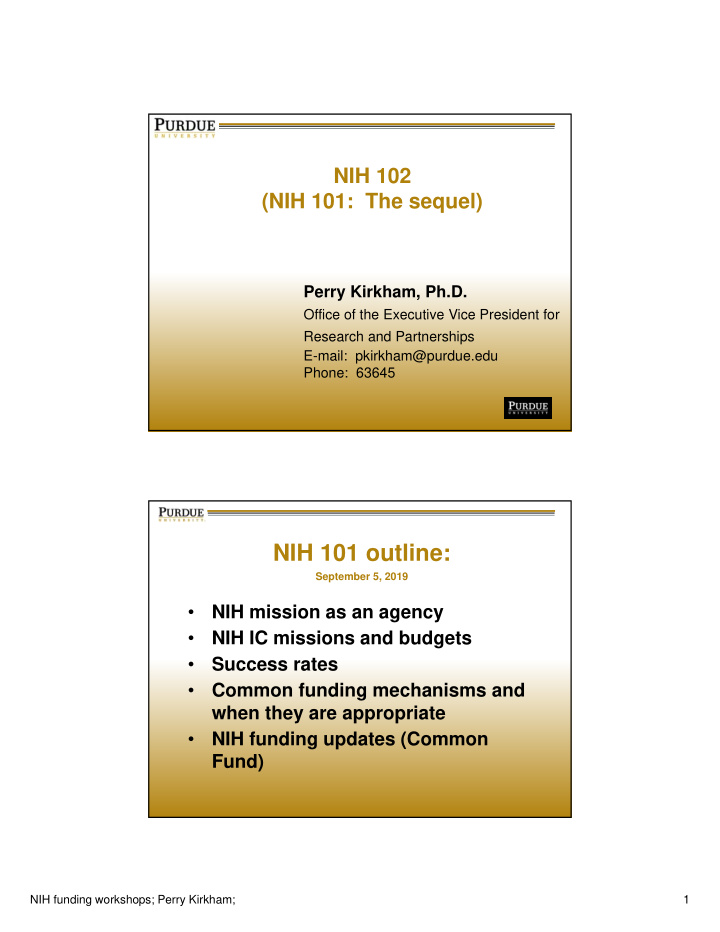



NIH 102 (NIH 101: The sequel) Perry Kirkham, Ph.D. Office of the Executive Vice President for Research and Partnerships E-mail: pkirkham@purdue.edu Phone: 63645 NIH 101 outline: September 5, 2019 • NIH mission as an agency • NIH IC missions and budgets Success rates • • Common funding mechanisms and when they are appropriate • NIH funding updates (Common Fund) NIH funding workshops; Perry Kirkham; 1
NIH 102 follow-up: Where should a grant proposal be • targeted? • How do I get it there? • Whom do I contact to help me answer these questions? What should I do to help my proposal be • reviewed well? • What is in a summary statement and what does it mean? NIH 102 follow-up: • Where should a grant proposal be targeted? • How do I get it there? What is your problem? What gap are you filling? NIH funding workshops; Perry Kirkham; 2
Targeting: What is the problem? What has been done already to address this problem? What is the gap that still remains (your north star)? How do you propose to address this gap? Dorothy Teegarden (NIH R01 CA232589-01A1; Obesity, Metabolism, and Breast Cancer Metastasis) What is the problem? What has been done already to address this problem? What is the gap that still remains? How do you propose to address this gap? PROJECT SUMMARY While significant evidence has demonstrated that obesity increases the risk of metastasis, the molecular mechanisms by which obesity contributes to the metastatic progression of breast cancer are unclear. Further, recent research in cancer development and progression has highlighted the role of metabolic reprogramming, which results in an increased supply of the cellular building blocks necessary for the increased cell proliferation and in adaptations required for cell survival in changing nutrient- and oxygen- containing environments. Research from our team and others demonstrates that the metabolic enzyme, pyruvate carboxylase, is upregulated during obesity and that this upregulation correlates strongly with breast cancer progression. Additional studies suggest that leptin, an adipokine whose expression is increased during obesity and whose receptor’s expression is enhanced in metastatic cells, drives pyruvate carboxylase expression in breast cancer cells. Importantly, recent studies demonstrate that genetic depletion of pyruvate carboxylase drastically inhibits breast cancer metastasis in several syngeneic mouse models. Despite the supporting evidence that pyruvate carboxylase contributes to breast cancer metastasis under obese conditions, the mechanisms by which this enzyme exerts this effect remain poorly understood. In the proposed studies, the research team will evaluate the mechanistic basis by which pyruvate carboxylase regulates obesity-driven breast cancer metastasis. They will test the hypotheses that leptin increases pyruvate carboxylase expression in mammary tissue during obese states, and that pyruvate carboxylase is critical for both migration and survival of extracellular matrix detachment, providing metabolic flexibility (e.g., glucose utilization and fatty acid metabolism) during metastasis. These hypotheses will be tested through completion of the following aims: 1) define the mechanisms of PC expression during metastasis; 2) elucidate the metabolic mechanisms by which PC promotes metastasis; and 3) establish the mechanisms by which leptin-regulated PC expression contributes to obesity-driven metastasis. Completion of these studies will result in valuable mechanistic information that could guide future development of evidence-based recommendations for those who are overweight and obese and that will help reduce breast cancer metastasis. NIH funding workshops; Perry Kirkham; 3
NIH funding workshops; Perry Kirkham; 4
NIH funding workshops; Perry Kirkham; 5
NIH 102 follow-up: • What should I do to help my proposal be reviewed well? Preliminary/feasibility data Judicious use of figures Grammar and consistency of outline NIH funding workshops; Perry Kirkham; 6
The need for preliminary data • Demonstrate that your proposed research is promising Demonstrate a credible ability to carry it out your proposal • • The more surprising the results the more data you will need to convince the reviewers • Must convince the reviewers of a high likelihood of success • Demonstrate that you can interpret or analyze data correctly The preliminary data must address your north star*. Do not include • data that does not help you address the north star of the proposal • Sometimes it is feasibility data • Insert it in the proposal where it is relevant *north star = the gap you are addressing NIH 102 follow-up: • What should I do to help my proposal be reviewed well? Judicious use of figures Grammar and consistency of outline NIH funding workshops; Perry Kirkham; 7
What should I do to help my proposal be reviewed well? Co-PIs, co-investigators, • consultants • Early stage investigators and/or new investigators • “A hammer in search of a nail” versus innovation or merging into a new field NIH 102 follow-up: • What is in a summary statement and what does it mean? NIH funding workshops; Perry Kirkham; 8
NIH funding workshops; Perry Kirkham; 9
NIH funding workshops; Perry Kirkham; 10
Recommend
More recommend